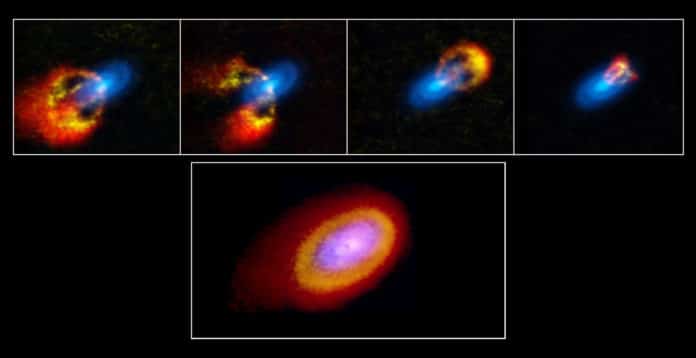Protoplanetary disks are known as the birthplace of planets. However, the exact process of planet-formation remains obscure.
A new study led by Teresa Paneque-Carreño–a recent graduate of the Universidad de Chile and Ph.D. student at the University of Leiden and the European Southern Observatory, focuses on unlocking the mystery of planet formation.
Using Atacama Large Millimeter/submillimeter Array (ALMA), scientists studied the young star Elias 2-27 and confirmed that gravitational instabilities play a crucial role in planet formation.
Located less than 400 light-years away from Earth in the constellation Ophiuchus, the Elias 2-27 star system exhibited gravitational instabilities, which occur when planet-forming disks carry a large fraction of the system’s stellar mass.
Paneque-Carreño said, “How exactly planets form is one of the main questions in our field. However, there are some key mechanisms that we believe can accelerate the process of planet formation. We found direct evidence for gravitational instabilities in Elias 2-27, which is very exciting because this is the first time that we can show kinematic and multi-wavelength proof of a system being gravitationally unstable. Elias 2-27 is the first system that checks all of the boxes.”
In 2016, it was found that the disk of the star system has a different structure than other star systems: this was something that was not observed in a protoplanetary disk before: two large-scale spiral arms.
Laura Pérez, Assistant Professor at the Universidad de Chile and the principal investigator on the 2016 study, said, “Gravitational instabilities were a strong possibility, but the origin of these structures remained a mystery, and we needed further observations.”
Teresa Paneque-Carreño–a recent graduate of the Universidad de Chile and Ph.D. student at the University of Leiden and the European Southern Observatory, said, “There may still be new material from the surrounding molecular cloud onto the disk, which makes everything more chaotic. This chaos has contributed to interesting phenomena that have never been observed before and for which scientists have no clear explanation.”
“The Elias 2-27 star system is highly asymmetric in the gas structure. This was completely unexpected, and it is the first time we’ve observed such vertical asymmetry in a protoplanetary disk.”
Cassandra Hall, Assistant Professor of Computational Astrophysics at the University of Georgia, and a co-author on the research, said, “the confirmation of both vertical asymmetry and velocity perturbations–the first large-scale perturbations linked to spiral structure in a protoplanetary disk–could have significant implications for planet formation theory. This could be a ‘smoking gun’ of gravitational instability, which may accelerate some of the earliest stages of planet formation. We first predicted this signature in 2020, and from a computational astrophysics point of view, it’s exciting to be right.”
Paneque-Carreño added, “while the new research has confirmed some theories, it has also raised new questions. While gravitational instabilities can now be confirmed to explain the spiral structures in the dust continuum surrounding the star, there is also an inner gap, or missing material in the disk, for which we do not have a clear explanation.”
Because of the high sensitivity of ALMA Band 6, paired with Bands 3 and 7, scientists were able to closely study the dynamical processes, density, and even the mass of the disk.
Credit: ALMA (ESO/NAOJ/NRAO)/T. Paneque-Carreño (Universidad de Chile), B. Saxton (NRAO)
Benedetta Veronesi–a graduate student at the University of Milan and postdoctoral researcher at École normale supérieure de Lyon, and the lead author on the second paper, said, “Previous measurements of protoplanetary disk mass were indirect and based only on dust or rare isotopologues. With this new study, we are now sensitive to the entire mass of the disk. This finding lays the foundation for developing a method to measure disk mass that will allow us to break down one of the biggest and most pressing barriers in the field of planet formation. Knowing the amount of mass present in planet-forming disks allows us to determine the amount of material available for the formation of planetary systems and to understand better the process by which they form.”
Paneque-Carreño said, “Studying how planets form is difficult because it takes millions of years to form planets. This is a very short time-scale for stars, which live thousands of millions of years, but a very long process for us. We can observe young stars with disks of gas and dust around them and try to explain why these disks of material look the way they do. It’s like looking at a crime scene and trying to guess what happened. Our observational analysis paired with future in-depth analysis of Elias 2-27 will allow us to characterize exactly how gravitational instabilities act in planet-forming disks and gain more insight into how planets are formed.”
Journal References:
- Spiral Arms and a Massive Dust Disk with non-Keplerian Kinematics: Possible Evidence for Gravitational Instability in the Disk of Elias 2-27, Paneque-Carreño et al. ApJ, preview
- A Dynamical Measurement of the Disk Mass in Elias 2-27, Veronesi et al. ApJ, preview
